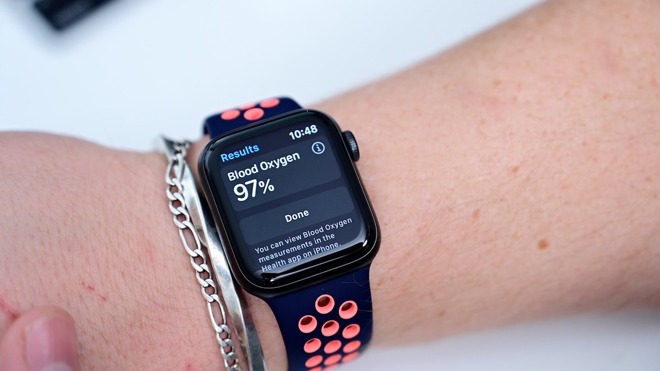Here's why Apple didn't need FDA clearance for Apple Watch Series 6 blood oxygen sensing
While Apple went to great lengths to garner government approval for Apple Watch Series 4's ECG feature, the company didn't do the same for a blood oxygen monitoring function on Apple Watch Series 6. Here's why.

Credit: Andrew O'Hara, AppleInsider
When the ECG feature was introduced on the Apple Watch Series 4, Apple made note that it navigated a lengthy approval process to gain clearance from the Food and Drug Administration.
As is typical in the consumer electronics industry, the blood oxygen feature on the Series 6 doesn't have similar certifications. According to The Verge, that's because pulse oximeters, also known as blood oxygen monitors, are in a different FDA classification. As long as a company doesn't claim that the devices can diagnose diseases, it can sell one in the U.S. with little oversight.
Generally, a company has to submit documentation to the FDA confirming the a blood oxygen sensing product works as well as other devices already on the market. But Apple, and other smartwatches and health-focused platforms, took another route. If a company claims a pulse oximeter is only used for general "wellness" or just for fun, it doesn't need to go through any type of approval process.
"Apple Watch is already a powerful health tool with apps that measure heart rate and heart rhythm. And now adding blood oxygen brings in another valuable health measurement to users," said Apple health chief Sumbul Ahmad Desai at the time of the device's release.
The Verge notes that the FDA does get involved if a health feature seeks to influence the medical care that a user gets. Apple's ECG feature falls into this category, since it serves the specific purpose of detecting and alerting users to unusual heart rhythms.
To even get the ECG cleared, Apple needed to submit documents and data proving that it could accurately detect a medical condition. It could.
And although Apple and other health partners are currently in the midst of studying how pulse oximeters can aid in the management and control of disease, there aren't yet any firm reports suggesting that it provides accurate information.

Credit: Andrew O'Hara, AppleInsider
When the ECG feature was introduced on the Apple Watch Series 4, Apple made note that it navigated a lengthy approval process to gain clearance from the Food and Drug Administration.
As is typical in the consumer electronics industry, the blood oxygen feature on the Series 6 doesn't have similar certifications. According to The Verge, that's because pulse oximeters, also known as blood oxygen monitors, are in a different FDA classification. As long as a company doesn't claim that the devices can diagnose diseases, it can sell one in the U.S. with little oversight.
Generally, a company has to submit documentation to the FDA confirming the a blood oxygen sensing product works as well as other devices already on the market. But Apple, and other smartwatches and health-focused platforms, took another route. If a company claims a pulse oximeter is only used for general "wellness" or just for fun, it doesn't need to go through any type of approval process.
"Apple Watch is already a powerful health tool with apps that measure heart rate and heart rhythm. And now adding blood oxygen brings in another valuable health measurement to users," said Apple health chief Sumbul Ahmad Desai at the time of the device's release.
The Verge notes that the FDA does get involved if a health feature seeks to influence the medical care that a user gets. Apple's ECG feature falls into this category, since it serves the specific purpose of detecting and alerting users to unusual heart rhythms.
To even get the ECG cleared, Apple needed to submit documents and data proving that it could accurately detect a medical condition. It could.
And although Apple and other health partners are currently in the midst of studying how pulse oximeters can aid in the management and control of disease, there aren't yet any firm reports suggesting that it provides accurate information.


Comments
*I bet they've thought of this!
Pulse oximetry is often subject to motion artifact making continuous readings during exercise difficult. In addition, exercise-induced hypoxia is rare in the absence of pulmonary disease. (when you exercise, it's increased CO2 that makes you short of breath, not decreased oxygen.)
Weirdly, it needs the Watch to be somewhat loose on the hand (a "no-no" according to Apple itself, when it comes to BPM measurement, for example), and it needs to be loosened from the wrist and moved further up in the lower arm to get a clean reading. The hand also has to be PERFECTLY still, and fingers outstretched. Perhaps it's still getting used to my hand. Not the end of the world to do all this, but it's a suboptimal experience, overall.
Hope there's a software fix of some kind, soon.
So far, and admittedly I haven't taken a deep dive into what can be achieved, it hasn't been particularly useful in this regard. But it's early days, and once I get a useful amount of data I'll be performing some analysis with my GP for everything that's getting logged. The BP graphs are reasonably nice to look at, though.
Maybe you just didn't like the part that others have been offering SpO2 measurement sensors for a while? Sure you didn't
Actually, decreased Sp)2 levels are a late sign of Covid. Increased heart rate predicts it earlier as the cardiorespiratory system try to compensate for the lung's inability to remove CO2 and oxygenate the blood.
There had actually been proposals to gather mass resting heart rate data by geographic area from FitBits and Apple Watches in order to predict viral hotspots -- such as "resting heart rates increased 10% in Tulsa. We need increase precautions in that area."